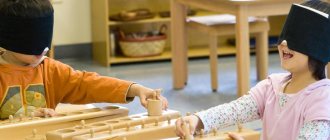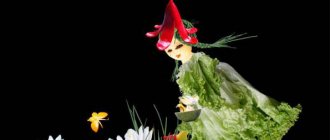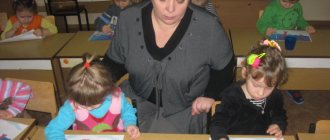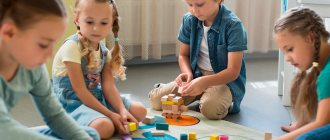What is a sensory room for?
It is well known that a person perceives himself and the world around him through receptors, nerve fibers and parts of the brain that react to light, color, sounds, smells and tactile sensations. Therefore, the combination of different stimuli (for example, light, sound or aromatherapy) makes it possible to have a complex effect on the human senses and achieve tremendous success in the development of children of all age categories. At the same time, the use of different sets of stimuli can have both a tonic/stimulating effect and a calming/relaxing effect.
Depending on the age category, the sensory room in kindergarten can be used:
- at an early age (1-3 years) - for the development of general and fine motor skills, the emotional sphere, tactile sensations, observation and attention, as well as the correction of motor disorders, visual coordination, indicative reactions and the enrichment of passive and active vocabulary;
- in preschool age (3-6 years) - for the development of involuntary and logical thinking, higher mental functions (memory, imagination, attention and perception), the emotional sphere, motivation to learn, cognitive interest, as well as learning relaxation skills, increasing resistance to stressful situations and psycho-emotional relief.
Please note that classes in the sensory room can be conducted both in groups and individually. In the case of group classes, the composition of the group is formed based on the needs and physical/psychological/emotional characteristics of each child. Depending on the needs of each group or individual child, classes are conducted in the following areas:
- psychocorrection of the emotional sphere and behavior - aggression and hot temper, isolation and self-doubt, attention deficit disorder and passivity, fears and hyperactivity;
- neuropsychological correction of “school” problems – lack of educational motivation and cognitive interest;
- developmental activities – development of higher mental functions and emotional sphere, achieving psycho-emotional relief, maintaining/restoring psychological health;
- psychotherapy for a wide range of psychoneurological problems.
Rules for organizing sensory education according to Montessori
Maria Montessori noticed that at a certain age, children's behavior and motivation are very similar. For example, in the first three years a child is especially sensitive to order. This childish “pedantry” is necessary for the child to create a stable image of this world. It can also be used to develop a child’s natural need for knowledge by creating tasks that are exciting for a certain age, which would help the child master the most important qualities of objects: color, size, shape, material.
As Maria Montessori herself admitted, the work of creating the sets was not easy: it was necessary to create material that would demonstrate properties in isolation, have pedagogical value, and at the same time be attractive to the child. This is how a set of Montessori sensory material appeared.
The main objectives of Montessori sensory exercises
- Teach the baby to perceive, compare and classify sensory experiences of different modalities,
- Expand the child’s sensory experience, teach him to notice even small differences, develop the child’s senses as much as possible,
- Teach your child to use his own memory: “I remember what yellow is, and I can always imagine it in my head,”
- Teach to critically evaluate any information and develop the habit of striving for maximum accuracy when gaining knowledge about the world,
- Create a basis for the emergence of abstract thinking and imagination.
Let us explain with an example how sensory and abstract thinking are connected:
Let's say you've never seen an okapi. Now your task is to imagine this animal by description: it is a bay horse with the legs of a zebra and the head of a giraffe. Happened? If so, congratulations, your sensory development is on point, because for this exercise you need to have an understanding of the colors of horses, the coloring of a zebra and the body structure of a giraffe.
Any abstract idea is essentially a clever interweaving of various information from our real experience. That is why a child’s intelligence begins in early childhood and the ability to exercise all the senses over and over again.
What can you find in the sensory development area of the Montessori center?
Visual information
- Shapes: sets of geometric shapes, as well as more complex shapes (for example, animal figures or plant leaves)
- Volumetric figures: Pink Tower, Brown staircase, Red barbells, Montessori weight cylinders
- Colors: sets of basic colors, card index of shades
Tactile information
- Texture: palpable board, rough tablets, baskets with rags
- Temperature: heat jugs, heat plates
- Weight: weighing cylinders and plates
Stereognostics
- Sorting small items, magic bag
Audio information
- Volume: sound boxes, musical accompaniment of classes
- Height: bells, sound cylinders, musical instruments
Taste and smell
- Taste bottles, conversations during meals
- Jars with scents
In addition to exercises with isolated sensory qualities, in a Montessori space you can always find sets that combine several qualities, such as color and shape:
- Binomial cube
- Trinomial cube
- Constructive triangles
- Montessori squares
- Cylinders without handle
The study of sciences according to M. Montessori also begins with sensory education. Acquaintance with the basic qualities of objects of the natural and cultural world prepares the child for studying social sciences, biology, physics, chemistry and even mathematics:
- Sets of leaves of different plants
- Thematic puzzles
- Maps and globe
- Flags
- Sets with natural materials
- Reproductions of artists and nature photographs
What is a sensory room?
Sensory room is a room equipped with stimulants that affect the organs of smell, touch, hearing, vision, etc., and aimed at the development of higher mental functions (speech, memory, thinking, attention, imagination, perception, etc.), emotional sphere and personal qualities of the child. In addition, such stimulants contribute to psycho-emotional relief (relaxation), restoration and maintenance of the psychological health of children.
To equip a sensory room, as a rule, the following equipment is used:
- air bubble columns – actively used for visual stimulation, stimulation of tactile sensations and relaxation;
- interactive touch panels - designed for sound and visual stimulation, development of imagination, creativity and fantasy, as well as for developing cause-and-effect relationships and interactive games;
- optical fiber with side glow - used to attract, maintain and stimulate attention;
- tactile panels – promote the development of imagination
, fine motor skills and physical activity, as well as the activation of physical activity and brain activity; - developmental and rehabilitation elements - aimed at developing physical skills, brain activity, general relaxation, toning muscles and achieving psychological balance of the child;
- decorative elements with lighting effects (suspended ceiling, ceiling modules, wall and floor carpets with fiber optics, light projectors, fluorescent paintings or mini-planetariums) - develop research interest, attract attention, promote the development of visual sensations and general relaxation.
In addition, the equipment of a sensory room almost always includes equipment used for sound and aromatherapy: odor generators, air ionizers and humidifiers, music panels, audio players, sets of CDs with musical works, etc.
Unusual lamps (for example, “Flame”, “Plasma”, “Vulcan” lamps or salt lamps), as well as non-standard upholstered furniture (for example, a ball ottoman, a water mattress or a cube chair) give the sensory rooms a special coziness and atmosphere of comfort. various soft play modules: transformable houses, dry pools with balls, educational tables, play screens, tactile paths, floor constructors and much more. In addition to its main purpose - conducting play activities, developing tactile sensations and physical abilities of children - the soft filling of sensory rooms has massage and relaxing effects, and also guarantees the safety of developmental activities.





